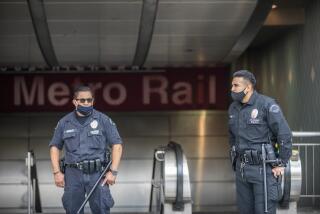Riders Vexed by Old Signs
As an agency responsible for 18,000 bus stops, the Metropolitan Transportation Authority sometimes has trouble keeping track of all its posted signs and schedules.
Some mistakes are innocuous. But other misleading and outdated information can be a real nuisance to those who depend on public transit, riders and advocates say.
In Sylmar, unwitting riders sometimes wait under an outdated MTA sign for buses that will never come.
In South-Central Los Angeles, bus stop displays advise riders to purchase their monthly transit passes and tokens from shops in the San Fernando Valley. Riders recently puzzled over the directory of authorized vendors in Van Nuys, Panorama City and Pacoima for buying MTA passes and tokens.
“Why would they put that here? It doesn’t have anything to do with this area,” said Deanna White, 15. “It’s got no point, no meaning.”
Joyce Flowers, a 40-year-old nurse, believes the posted information is correct. MTA “wouldn’t put false stuff up there,” Flowers said. “That just means [the Valley is] the best place to buy tokens and passes.”
At one stop, the posted schedule for buses going east, from Marina del Rey to Pico Rivera, says the service is “westbound.”
“The information is just not accurate,” said Esther Garcia, a 23-year-old teacher’s aide, as she waited for a bus near a South-Central street corner. “I don’t expect much from these signs. I don’t even look at them anymore.”
No one knows the extent of the problem. Some riders say they believe mistakes are pervasive. MTA officials say they haven’t received many complaints about erroneous information displays or schedules, but concede there may be some inaccuracies.
“We’re not infallible,” said Warren Morse, deputy executive officer of marketing and customer relations. “If someone finds something inaccurate, we want to check it out so we can take corrective action.”
A team of 16 employees works full time, seven days a week trying to keep MTA’s signs and information displays clean and up-to-date, said Pete Serdienis, facilities maintenance manager. Twice a year, when the agency modifies its bus routes, employees scramble across Los Angeles County to update 4,000 to 6,000 signs.
Posting route maps, schedules and other helpful information at bus stops can boost ridership by making transit easier to use, experts say.
“It’s the responsibility of the transit agency to make sure the information is correct,” said Paul Larrousse, director of the National Transit Institute of Rutgers University. “You’ve got to devote staff and financial resources to maintaining it.”
During the last year, the MTA has installed hundreds of information cubes that display routes and schedules at bus stops, and has affixed hundreds of information decals to bus stop poles.
But the agency needs to work harder to make sure that its signage is accurate and current, riders and public transit advocates say.
“Some of the work is laughable and embarrassing,” said Bart Reed, executive director of the Transit Coalition, an advocacy group based in Sylmar. “It’s done in such a stupid manner.”
Some areas have so-called orphan bus stops, which advertise routes that no longer exist, riders say. At Sylmar Juvenile Hall, employees say they’ve warned visitors that buses no longer serve the detention center, but some are still fooled by an MTA sign in front of the facility.
Cynthia Seten, a senior detention services officer, and others have seen people waiting for the phantom bus. “People don’t know; they’re stuck,” she said.
Other riders complain that buses often don’t arrive at scheduled times. The signs are “useless,” said Wenlu Shen, 74, a retired accountant from Alhambra, glaring at a bus stop information cube in Chinatown. “Nobody looks at them.”
Erroneous transit signs can impede the MTA’s efforts to improve service. Along one Van Nuys route, where buses recently were added, information dating from 1997 says buses arrive every 30 to 40 minutes on Saturdays. In fact, they run every 15 minutes.
When informed of the errors, MTA officials said they would remove or correct the signs.
“We encourage the public to call us, to contact us,” said spokesman Gary Wosk. “We can’t correct [mistakes] unless we know about them.”
But others believe the burden shouldn’t be on riders to report such errors.
“I wish those responsible at the agency would test their signage a lot more than they do,” Reed said. “They should have the ability to get it right the first time.”
More to Read
Sign up for Essential California
The most important California stories and recommendations in your inbox every morning.
You may occasionally receive promotional content from the Los Angeles Times.









